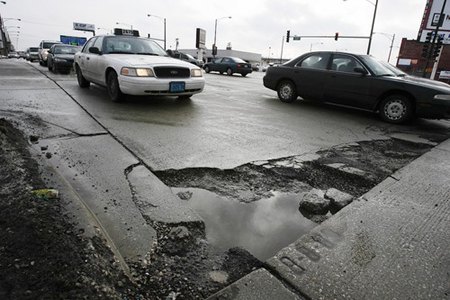Ford: Don't Swerve or Slow Down for Potholes
New Year’s Day is taking a bizarre turn, as Ford reveals the new Shelby Mustang GT500 Shelby Mustang Cobra Shelby Mustang GT500 on the same day that it’s advising motorists how to deal with what it calls “chuck holes.” Is that a regional thing, and what do woodchucks have to do with pavement other than, how do I put this.. splat? Anywho, here’s FoMoCo spinmeister Wes Sherwood’s take on pothole etiquette. “If safe, don’t swerve to avoid potholes. Swerving can create a situation where the front wheel and tire on the car can impact the edge of the pothole at an obtuse angle, which might do more damage than hitting it squarely. If safe, don’t brake just because you see a pothole: heavy braking compresses the front suspension of the car and will have a tendency to force the tire and wheel down into the pothole, instead of gliding over.” Oh, BTW: “To give drivers a fighting chance with monster potholes, [Ford] engineers tune shock rebound rates to keep the wheel and tire suspended so it can glide over the pothole, preventing the tire from dropping down into it and impacting the edge of the tire and wheel.” Gliding over potholes. Well I never!
More by Robert Farago


































Comments
Join the conversation
Ford guy has good advice, but I'm still going to drive around them when I can. I do brake if I can't avoid hitting the hole, but release the brakes with enough time to allow the suspension to recover and accept the impact. I used to drive a '02 Honda Civic, and the struts in that thing would blow out dropping off the concrete lip leaving a parking lot, so I got pretty good at saves.
I've been doing this all my life. Rule 1. Swerve before pothole to awoid it Rule 2. If rule 1 don't work, lets say because there is a series of potholes, Slow down prior and release brakes before crossing. Note that with some potholes you need to come to the full stop before crossing them without damaging your car. Rule 3. Small potholes can be simly and safely run over with the fast speed. As result of this tactics, I never had a blown tire, missaligned or damaged suspention.
What kind of smoothed road utopia do you live in R.F.? I live in Michigan where all this is common knowledge, or so I always thought. Same rules apply to gravel roads. I've never heard the term chuck-hole though.
It really depends on the size (in the direction of travel), depth, and steepness of the walls of the pothole relative to the speed of the vehicle, as well at the tire size/aspect ratio, and the type of wheel (alloy/steel). In PA, you learn how to take all of these factors into account in order to keep the little donut in the trunk (where it belongs).